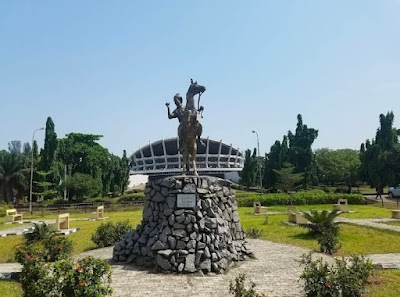National Arts Theatre (National Arts Theatre)
Overview
The National Arts Theatre, located in Garki, Nigeria, is a cultural landmark that embodies the nation's rich artistic heritage. While many associate the theatre with Lagos, Garki, a vibrant area in the capital city of Abuja, boasts its own dynamic cultural scene that draws visitors from far and wide each year.
Constructed in 1976 in anticipation of the Festival of Arts and Culture (FESTAC) in 1977, the theatre represents a monumental achievement in Nigeria's cultural history. This event, the second edition of its kind, celebrated African arts and culture, attracting participants from across the continent. The theatre's establishment was no small feat, initiated under General Yakubu Gowon and completed during General Olusegun Obasanjo's administration. Its design, inspired by the Palace of Culture and Sports in Varna, Bulgaria, stands as a testament to Nigeria's commitment to preserving its cultural identity and artistic excellence.
The architecture of the National Arts Theatre is itself a marvel, designed to resemble a military hat when viewed from above. This iconic structure is a highlight of modernist architecture intertwined with African aesthetics. The main hall accommodates 5,000 seats and features a collapsible stage, enabling a wide range of performances from dramatic plays to lively musical concerts. Additionally, the theatre includes two cinema halls, each with a seating capacity of 700, dedicated to showcasing films from Nigeria's flourishing Nollywood industry alongside international productions.
Significantly, the National Arts Theatre has become a nurturing ground for Nigeria's cultural and creative industries, fostering the growth of visual arts, theatre, music, dance, film, and literature. This vibrant space allows artists to showcase their work while contributing to the preservation and celebration of Nigeria's diverse cultural heritage. The theatre buzzes with activity, hosting a wide array of events such as arts exhibitions, cultural festivals, and national celebrations. The annual National Festival of Arts and Culture (NAFEST) transforms the venue into a lively showcase of colorful performances and exhibitions, offering a glimpse into Nigeria's artistic diversity.
In addition to serving as a cultural hub, the National Arts Theatre is an educational resource for students and researchers eager to explore the depths of Nigerian and African arts. The facility features a well-stocked library filled with books, periodicals, and multimedia materials on various aspects of art and culture. This resource center acts as a crucible of knowledge where the past, present, and future of Nigerian art converge.
For foreign tourists, a visit to the National Arts Theatre offers an immersive experience into the heart of Nigerian culture. The theatre often provides guided tours that delve into its history, architecture, and the diverse cultural activities it hosts. Knowledgeable guides lead these tours, sharing detailed explanations and intriguing anecdotes that bring the theatre's rich history to life.
One fascinating aspect of the National Arts Theatre is its pivotal role in the development of Nollywood, Nigeria's film industry, recognized as one of the largest in the world. The cinema halls have premiered numerous films, providing a prestigious platform for filmmakers to launch their works. This dynamic relationship between the theatre and Nollywood underscores the venue's significance as a cultural progenitor.
Visitors can also take in the lush surroundings of the theatre, which serve as a serene backdrop for its striking structure. The grounds are adorned with statues and sculptures by prominent Nigerian artists, encapsulating the spirit of the country’s artistic tradition. These outdoor art pieces not only provide aesthetic pleasure but also offer a deeper understanding of Nigeria's artistic narrative.
In conclusion, the National Arts Theatre in Garki is more than just a building; it is a beacon of cultural pride and artistic pursuit. It serves as a cultural preserve that offers a window into the soul of Nigeria, showcasing its artistic diversity and heritage. For any foreign tourist seeking to comprehend the essence of Nigerian art and culture, a visit to this theatre is essential. It promises an enriching journey through Nigeria's history, as well as its vibrant present and future of creativity.







